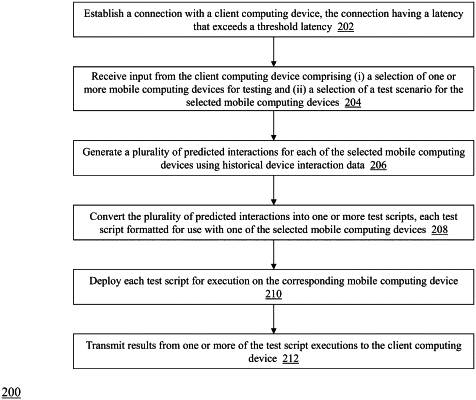| CPC G06F 11/3688 (2013.01) [G06F 11/3684 (2013.01)] | 24 Claims |

|
1. A computerized method of automated testing of mobile computing devices, the method comprising:
establishing, by a server computer, a connection with a client computing device, the connection having a latency that exceeds a threshold latency;
receiving, by the server computer, input from the client computing device comprising (i) a selection of one or more mobile computing devices for testing and (ii) a selection of a test interaction for the selected mobile computing devices;
generating, by the server computer, a plurality of predicted interactions for each of the selected mobile computing devices using historical device interaction data and the selection of the test interaction, the plurality of predicted interactions based upon the selected test interaction, the plurality of predicted interactions comprising a hierarchical data structure where each path from a root node of the hierarchical data structure to a leaf node of the hierarchical data structure comprises a workflow to be tested,
wherein the historical device interaction data comprises a plurality of interactions captured from manual testing,
the server computer executes a sequential pattern mining algorithm on the historical device interaction data to generate a set of interaction subsequences each associated with an occurrence frequency, and
the server computer identifies one or more of the interaction subsequences that have one or more prefix interactions that correspond to the selection of the test interaction and selects one or more suffix interactions of the identified interaction subsequences based upon the prefix interactions;
converting, by the server computer, the plurality of predicted interactions into one or more device-specific test scripts, each device-specific test script formatted for use with one of the selected mobile computing devices, comprising: extracting a plurality of workflows from the hierarchical data structure, generating a device-agnostic application test script for each extracted workflow, and converting each device-agnostic application test script into a device-specific test script for execution by one of the selected mobile computing devices;
deploying, by the server computer, each device-specific test script for execution on the corresponding mobile computing device; and
transmitting, by the server computer, results from one or more of the device-specific test script executions to the client computing device.
|